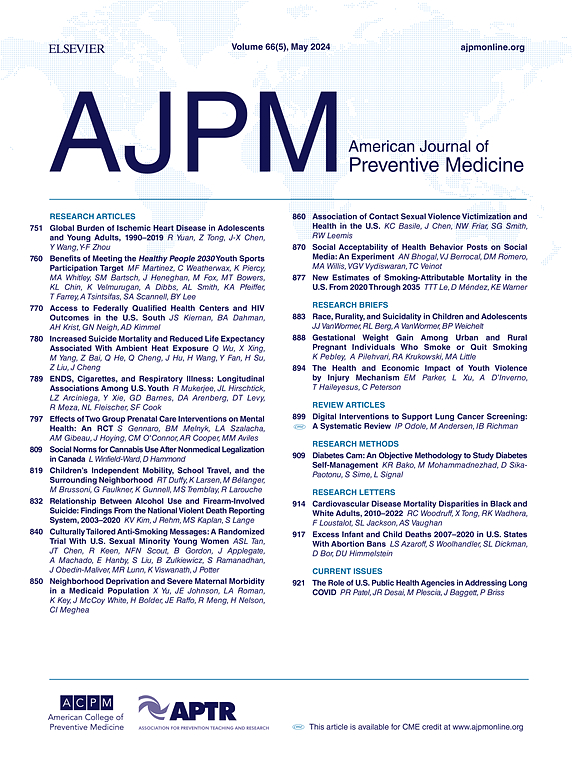Evaluating School-Based Interventions for Preventing and Reducing Tobacco Use Among Adolescents in Low- and Middle-Income Countries: A Systematic Review and Meta-Analysis
IF 4.3
2区 医学
Q1 MEDICINE, GENERAL & INTERNAL
引用次数: 0
Abstract
Introduction
Tobacco-related disease and death remain high in many low- and middle-income countries, and most people start using tobacco during adolescence. This study evaluated the effectiveness of school-based interventions in preventing and reducing tobacco use among adolescents in low- and middle-income countries.
Methods
Seven databases were searched until 20 April 2024. The primary outcome was tobacco use prevalence (ever or point prevalence) at the longest follow-up. Risk of bias was assessed, and random-effects meta-analyses were conducted, exploring heterogeneity via meta-regression (PROSPERO registration CRD42022330329).
Results
Twenty-seven studies (N=57,292) were summarized descriptively, and 20 were meta-analyzed. Most studies were from Brazil (n=5, 18.5%), India (n=5, 18.5%), China (n=3, 11.1%), and Pakistan (n=2, 7.4%); 12 (44.4%) assessed newly developed and 15 (55.6%) culturally adapted existing interventions; and over half (n=14, 51.9%) focused solely on preventing and reducing tobacco use while the rest addressed multiple behaviors. Overall, interventions reduced adolescent tobacco use (OR=0.76, 95% CI=0.64, 0.91; I²=47%; n=20; 50,056 participants). Stratification by outcome measure showed significant reductions in point prevalence (OR=0.69, 95% CI=0.57, 0.85; I²=32.4%). After adjusting for study duration, interventions with higher contact time had lower effectiveness than shorter interventions (AOR=1.36, 95% CI=1.01, 1.84; p=0.045; I²=22%). Low risk of bias studies demonstrated lower odds of tobacco use among participants (OR=0.66, 95% CI=0.50, 0.87; I²=14%; n=6).
Discussion
School-based interventions in low- and middle-income countries effectively reduce the proportion of adolescents who use tobacco. Shorter interventions appeared to be effective, suggesting that brief yet engaging interventions may offer practical advantages and could contribute to addressing the tobacco epidemic in low- and middle-income countries. Further research is needed to determine optimal intervention duration and intensity for sustained effectiveness.
评估以学校为基础的预防和减少中低收入国家青少年烟草使用的干预措施:系统回顾和荟萃分析
导言:在许多低收入和中等收入国家,与烟草有关的疾病和死亡率仍然很高,大多数人在青春期开始使用烟草。本研究评估了以学校为基础的干预措施在中低收入国家青少年中预防和减少烟草使用方面的有效性。方法:截至2024年3月20日,检索7个数据库。主要结局是最长随访期间的烟草使用流行率(曾经或点流行率)。评估偏倚风险(RoB),并进行随机效应荟萃分析,通过meta回归探索异质性(PROSPERO注册号CRD42022330329)。结果:27项研究(n=57,292)进行了描述性总结,20项进行了meta分析。大多数研究来自巴西(n=5, 18.5%)、印度(n=5, 18.5%)、中国(n=3, 11.1%)和巴基斯坦(n=2, 7.4%);12项(44.4%)评估了新开发的干预措施,15项(55.6%)评估了适应文化的现有干预措施;超过一半的国家(n=14, 51.9%)只关注预防和减少烟草使用,其余国家则关注多种行为。总体而言,干预措施减少了青少年烟草使用(优势比[OR] 0.76, 95%可信区间[CI]: 0.64-0.91;²= 47%;n = 20;50056名参与者)。结果测量分层显示点患病率显著降低(OR 0.69, 95% CI: 0.57-0.85;²= 32.4%)。在调整研究时间后,接触时间较长的干预措施的有效性低于接触时间较短的干预措施(调整OR为1.36,95% CI: 1.01-1.84;p = 0.045;²= 22%)。低RoB研究表明,参与者使用烟草的几率较低(OR 0.66, 95% CI: 0.50-0.87;²= 14%;n = 6)。讨论:低收入中低收入国家以学校为基础的干预措施有效地降低了青少年使用烟草的比例。较短的干预措施似乎是有效的,这表明,简短而引人入胜的干预措施可能带来实际优势,并有助于解决中低收入国家的烟草流行问题。需要进一步的研究来确定持续有效的最佳干预时间和强度。
本文章由计算机程序翻译,如有差异,请以英文原文为准。
求助全文
约1分钟内获得全文
求助全文
来源期刊

American Journal of Preventive Medicine
医学-公共卫生、环境卫生与职业卫生
CiteScore
8.60
自引率
1.80%
发文量
395
审稿时长
32 days
期刊介绍:
The American Journal of Preventive Medicine is the official journal of the American College of Preventive Medicine and the Association for Prevention Teaching and Research. It publishes articles in the areas of prevention research, teaching, practice and policy. Original research is published on interventions aimed at the prevention of chronic and acute disease and the promotion of individual and community health.
Of particular emphasis are papers that address the primary and secondary prevention of important clinical, behavioral and public health issues such as injury and violence, infectious disease, women''s health, smoking, sedentary behaviors and physical activity, nutrition, diabetes, obesity, and substance use disorders. Papers also address educational initiatives aimed at improving the ability of health professionals to provide effective clinical prevention and public health services. Papers on health services research pertinent to prevention and public health are also published. The journal also publishes official policy statements from the two co-sponsoring organizations, review articles, media reviews, and editorials. Finally, the journal periodically publishes supplements and special theme issues devoted to areas of current interest to the prevention community.
 求助内容:
求助内容: 应助结果提醒方式:
应助结果提醒方式:


